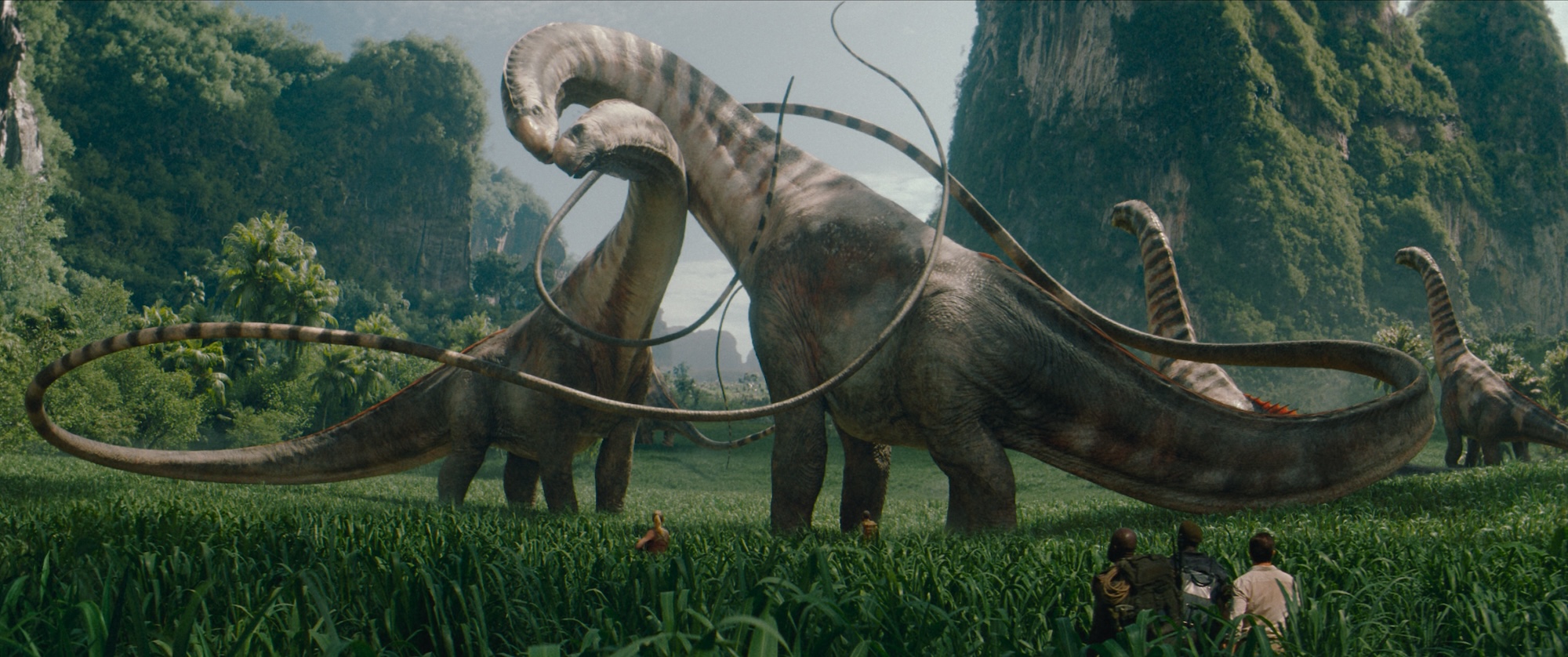In ‘Jurassic World,’ A Speculative Glimpse At Dinosaur Love
In the one good scene in “Jurassic World Rebirth,” 100-foot-long titanosaurs do some G-rated mating.
This is an article from our newsletter “Science Goes To The Movies.” To get a story about the science of popular movies and TV in your inbox every month, subscribe here.
The dinosaurs of the “Jurassic World” franchise get a bad rap, akin to the shark in “Jaws.” But for 2 minutes in “Jurassic World Rebirth,” the movie pauses the stereotype of dino killing machines and we get to watch titanosaurs the size of 7-story buildings nuzzle each other in a presumed courtship display.
It’s both captivating and adorable, but is it based in science? Or was the only good scene in this movie all artistic liberty?

Scientists learn about dinosaurs’ anatomy, and when and where they lived, by analyzing fossil remains. But deducing behavior based on fossil evidence is much more difficult, says Dr. Matt Lamanna, curator of vertebrate paleontology at Carnegie Museum of Natural History in Pittsburgh, Pennsylvania.
“It’s effectively trying to infer behavior from a corpse,” Lamanna says.
Lamanna has helped uncover and describe several titanosaurs—giant, long-necked dinosaurs that could grow to about 100 feet long and lived all over the world during the Cretaceous period. If you saw “Jurassic World Dominion” from 2022, you’ve seen the Dreadnoughtus species of these goliaths in action (which Lamanna first described).
Some titanosaur social behavior can be inferred from fossilized remains. For example, multiple sites worldwide have fossilized titanosaur tracks that show footprints all facing the same direction, indicating that these dinosaurs “probably moved around in herds or social groups,” Lamanna says. Similarly, fossilized nesting sites in Argentina show that titanosaurs laid eggs and likely nested communally.
Evidence of their mating behaviors is limited—the nuzzling in “Jurassic World Rebirth,” is a bit of artistic speculation. Lamanna adds that researchers can make inferences about dinosaur behavior by looking at two modern-day animals that together create an “evolutionary sandwich” with dinos—crocodiles, which evolved before dinosaurs, and birds, which evolved after.
“If a croc does it and a bird does it, there’s a defensible argument that a dinosaur did it too,” Lamanna says.
Earlier this year, a group of ichnologists—researchers who study traces ancient animals leave behind, like burrows and nests—published an analysis of fossilized theropod foot scrape markings mostly found in western Colorado. Theropods are the group of dinosaurs that include T. rex and are most related to modern-day birds.
At Dinosaur Ridge, the researchers found more than 20 markings embedded in rock, facing all directions and positioned relatively close together. While scientists can’t definitively know why the markings were made, Dr. Caldwell Buntin, an ichnologist at Old Dominion University and first author on the paper, says that the placement and position of the markings help rule out some hypotheses.

For example, the scrapes being close together likely means that they aren’t territorial markings, which are more spaced out. The location, near an ancient body of water where food would have been abundant, suggests that they probably weren’t made while dinos were digging for food or water. And while theropods did scrape while making nests, those markings tend to be equally spaced, with consistent shapes and sizes, whereas the ones described in the paper were much more varied, Buntin says.
But the findings did suggest similarities between the fossilized markings and those made by modern birds during mating rituals. After comparing measurements of similar markings from modern-day birds, Buntin concluded that these Cretaceous foot scrapes could be evidence of a nesting display dance seen in birds like the male banded plover, which woos females with a dance that involves kicking and scraping its feet into the dirt near the females’ nests.
Both Lamanna and Buntin acknowledge that ichnology is one of the few strategies researchers have to understand dinosaur mating behavior, but it requires some interpretation. “It’s not like bones,” Buntin says. “We do have to be creative when we’re looking at these.”
No. It’s clear that we can pump out “Jurassic World” movies, but this film fails to make a case that we should.
“Jurassic World Rebirth” is in theaters now.
Emma Lee Gometz is Science Friday’s Digital Producer of Engagement. They write SciFri’s “Science Goes To The Movies” series and are a journalist and illustrator based in Queens, NY.